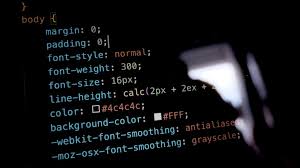
The Art of Web Design Coding
Web design coding is the backbone of creating visually appealing and functional websites. It involves using various programming languages, such as HTML, CSS, and JavaScript, to bring a design concept to life on the web.
HTML (HyperText Markup Language)
HTML is the foundation of web design coding. It provides the structure and content of a webpage by using elements like headings, paragraphs, images, and links. With HTML, web designers can create a well-organised layout that is easy to navigate for users.
CSS (Cascading Style Sheets)
CSS is used to style the HTML elements created in a webpage. It allows designers to control the visual presentation of their content, including aspects like colours, fonts, spacing, and layout. CSS plays a crucial role in making websites visually appealing and user-friendly.
JavaScript
JavaScript adds interactivity and dynamic behaviour to websites. It enables designers to create animations, interactive forms, and other engaging features that enhance user experience. JavaScript is essential for creating responsive and interactive web designs.
Responsive Design
Responsive design coding ensures that websites adapt to different screen sizes and devices. By using techniques like media queries and flexible layouts, web designers can create sites that look great on desktops, tablets, and smartphones. Responsive design coding is vital for providing a seamless user experience across various devices.
Conclusion
Web design coding is an essential skill for creating modern websites that are both visually appealing and functional. By mastering HTML, CSS, JavaScript, and responsive design techniques, designers can bring their creative visions to life on the web.
Top 5 FAQs on Enhancing Your Web Design Coding Skills
- What programming languages are commonly used in web design coding?
- How can I improve my skills in HTML, CSS, and JavaScript for web design?
- What is the importance of responsive design in web development?
- How do I create visually appealing layouts using CSS in web design coding?
- Are there any tools or software that can help streamline the web design coding process?
What programming languages are commonly used in web design coding?
In the realm of web design coding, several programming languages are commonly utilised to bring websites to life. HTML (HyperText Markup Language) serves as the foundation for structuring web content, while CSS (Cascading Style Sheets) is employed to style and format elements on a webpage. JavaScript is another prevalent language used for adding interactivity and dynamic features to websites. Additionally, programming languages like PHP, Python, and Ruby on Rails are often integrated for backend development tasks in web design coding. By leveraging a combination of these languages, web designers can create visually appealing, interactive, and functional websites that cater to modern user expectations.
How can I improve my skills in HTML, CSS, and JavaScript for web design?
To enhance your proficiency in HTML, CSS, and JavaScript for web design, consider practising regularly by working on projects that challenge your skills. Utilise online resources like tutorials, courses, and coding exercises to deepen your understanding of each language. Additionally, study the latest trends and best practices in web design coding to stay updated with industry standards. Collaborating with other developers, attending workshops or web design events, and seeking feedback on your work can also help you improve your skills and grow as a web designer. Remember that continuous learning and hands-on experience are key to mastering HTML, CSS, and JavaScript for effective web design.
What is the importance of responsive design in web development?
Responsive design is a critical aspect of web development as it ensures that websites can adapt and provide an optimal viewing experience across various devices, including desktops, tablets, and smartphones. With the increasing use of mobile devices to access the internet, responsive design coding plays a vital role in ensuring that websites are user-friendly and visually appealing on any screen size. By implementing responsive design techniques, web developers can enhance usability, improve accessibility, and ultimately deliver a consistent experience to users regardless of the device they are using.
How do I create visually appealing layouts using CSS in web design coding?
Creating visually appealing layouts using CSS in web design coding involves a combination of creativity and technical skill. To design eye-catching layouts, web designers can utilise CSS properties such as background colours, gradients, borders, padding, and margins to enhance the visual appeal of elements on a webpage. Employing CSS flexbox or grid layout systems can help in achieving responsive and well-structured designs that adapt seamlessly to different screen sizes. Additionally, incorporating animations and transitions using CSS can add a touch of interactivity and elegance to the layout. By mastering these CSS techniques and experimenting with different design approaches, designers can craft visually stunning layouts that captivate users and elevate the overall aesthetic of a website.
Are there any tools or software that can help streamline the web design coding process?
When it comes to streamlining the web design coding process, there are several tools and software available that can significantly enhance efficiency and productivity. Tools like code editors such as Visual Studio Code, Sublime Text, or Atom offer features like syntax highlighting, auto-completion, and debugging capabilities that make coding faster and more accurate. Frameworks like Bootstrap or Foundation provide pre-built components and responsive layouts that can speed up the development process. Additionally, version control systems like Git help manage code changes effectively, while task runners like Gulp or Grunt automate repetitive tasks. These tools play a crucial role in simplifying and optimising the web design coding workflow for designers and developers alike.
